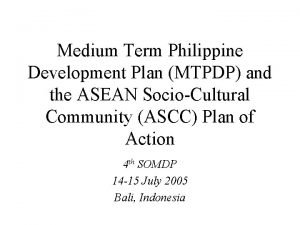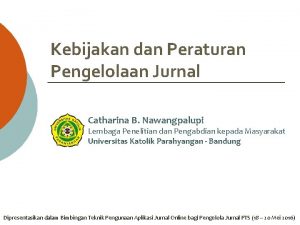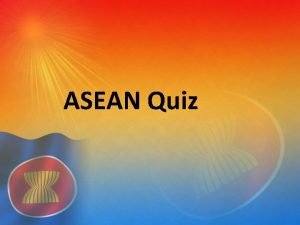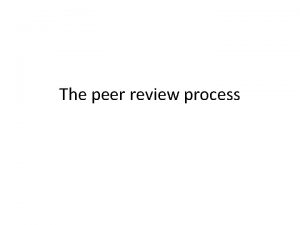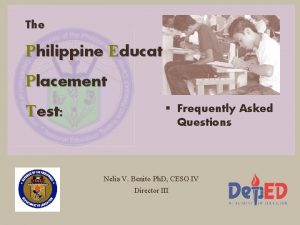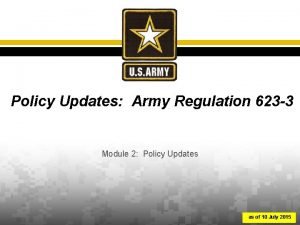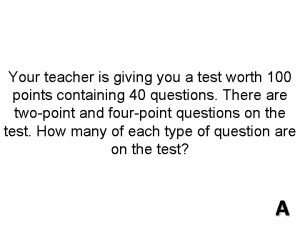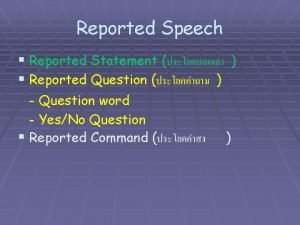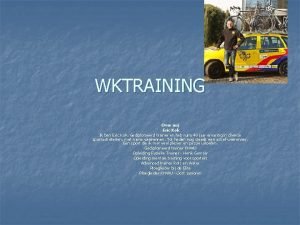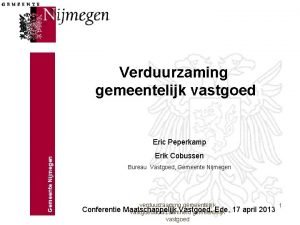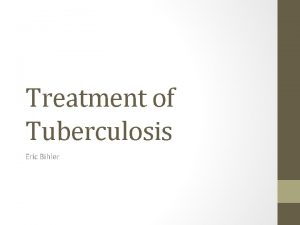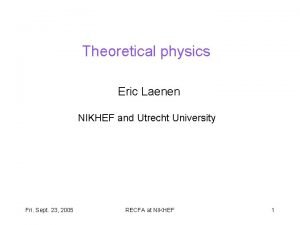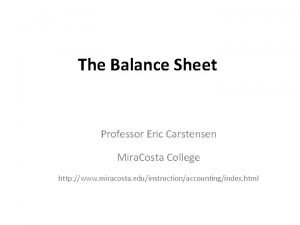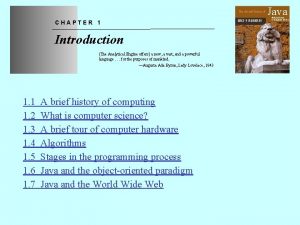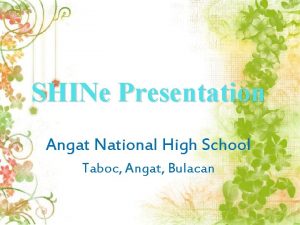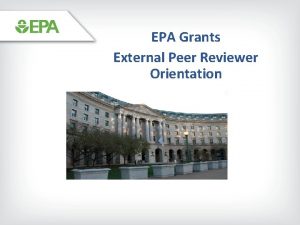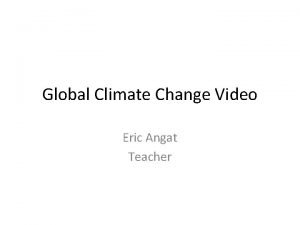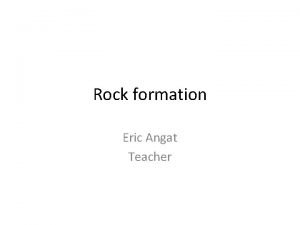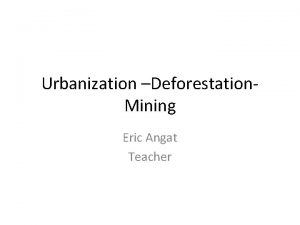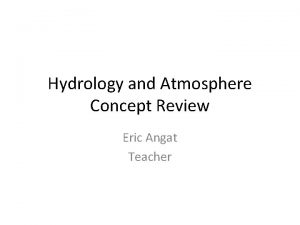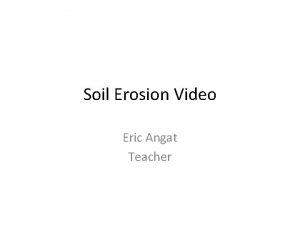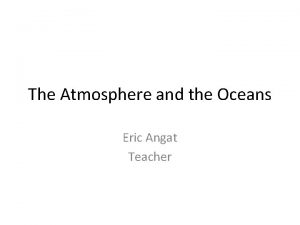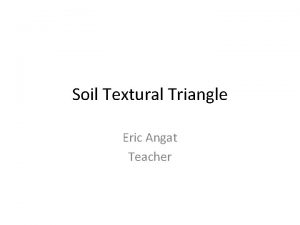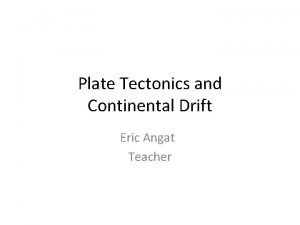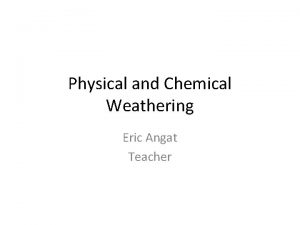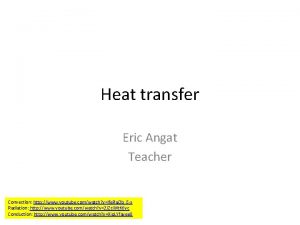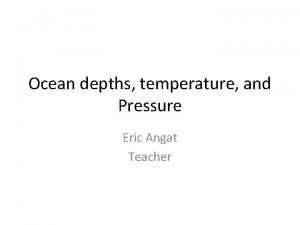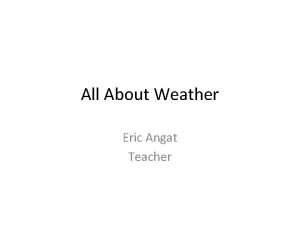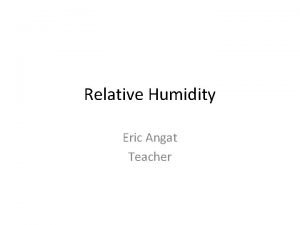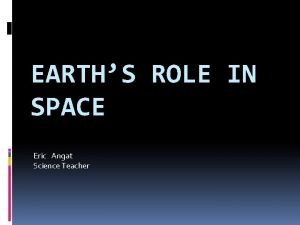Reviewer Eric Angat Teacher 1 What do you







































- Slides: 39

Reviewer Eric Angat Teacher

1. What do you call the water in the aquifer and water table? Groundwater Includes all the water underground. Water table groundwater Impermeable rocks aquifer

2. How is groundwater recharge attained? PRECIPITATION PERCOLATION groundwater Recharge happens when water percolates into the ground.

3. What happens when the water table rises above the surface of the earth? Flood Water table groundwater happens when the water table rises above the surface.

4. What is a divide? A Divide is land that separates two bodies of water. Divide

5. Why are Riparians buffers important? Riparian buffers ( trees, shrubs, grasses on riverbanks) are important for good water quality. Non-point source pollution is removed from runoff by plants before reaching the river or stream. Erosion is prevented

Riparian buffers are important for good water quality. Riparian zones help to prevent sediment and pollutants from reaching a stream. Riparian buffers include a native grass or herbaceous filter strip along with deep rooted trees and shrubs along the stream. NO Runoff with sediments and Corn riparian excess fertilizers. buffer farm Sediments and nitrates pollutes River the river or stream.

6. What makes up a river basin? Mississippi River Basin There are many smaller watersheds within a river basin. Rivers and streams drains the watersheds.

precipitation tributaries watershed river Precipitation that falls flows downward usually creating a stream or river. The area of land that contributes water to a stream or river is called a watershed, or drainage basin.

Watershed divide Land separating two watersheds.

7. What kind of heat transfer is responsible for the rising of warm air masses from the equator and sinking of cold air masses from the poles? Convection Warm air mass rises from the equator while cold air mass sinks from the poles.

Convection Warm water rises while cold water sinks.

8. A chemical factory accidentally released toxic chemicals at Cape Fear. What major city will be greatly affected? A. Winston. Salem B. Fayetteville C. Goldsboro D. Wilmington

9. How are we affected by deforestation and urbanization? DEFORESTATION • Less oxygen • More carbon dioxide URBANIZATION • Less habitat for animals • Less biodiversity

10. What benefits do we get from reforestation? Runoff/flooding reduction CO 2 reduction in air. Less greenhouse effect, and acid rain. Habitat for animals. Greater biodiversity. Adds O 2 in air. Better air quality.

11. How are the oceans affected by increasing temperatures or global warming? Humidity increases means more or stronger precipitations. More water evaporation Sea Ice melts, addingsalinity more freshwater in the oceans from means causes seawater increases. rise and flooding on low lying areas and coastlines.

12. How is water affected by temperature increase? Warm water rises due to its lower density. Convection

12. How is water affected by temperature increase? Warm water loses its dissolved oxygen.

13. How do aquatic organisms benefit from upwelling in the ocean? Wind causes waves and upwelling. Upwelling ( rising ) water brings food near the ocean surface. Sea creatures feed.

14. Which layer of the atmosphere is the coldest and the hottest? Hottest Thermosphere Coldest Mesopause Mesosphere stratosphere -90 Celsius Troposphere 90 Celsius

15. What is the portion of land into which an area drains all of its streams and tributaries? A. watershed B. tributaries C. riverbank D. groundwater

16. What benefit can a riparian buffer provide to the river in an agricultural area? A. prevent erosion of loose soil from crops B. reduce non-point source pollution of surface water

17. What separates one watershed from another? A. divide B. aquifer C. mountain D. river basin

18. What is a negative consequence of deforestation? reducing the effects of global A. making space to grow crops warming is a GOOD consequence. B. reducing the effects of global warming C. Less area for animal habitats D. increasing biodiversity

19. Which can hold more water vapor cold air or warm air? Warm air: Less dense Cold air: More dense Warm Air - Not as many air molecules Cold Air - More air molecules

Cold air has less spaces between molecules that is why it is more dense and it sinks and water vapor condenses. . Humidity increases. Warm air has more Water vapor condenses spaces between followed by molecules that is why precipitation. it is less dense and it rises.

Temperature: 53 F Temperature: 52 F Temperature: 51 F 20. The weather forecast is sunny skies with a temperature of 87 F and a dew point of 61. Why will it become more humid if the temperature were to drop? A. water vapor would condense B. water vapor would expand

21. What is an estuary? River flows downstream into the ocean. Estuary River water ( freshwater) Rising tides can cause the mixes with ocean water ( estuary water to become salty water) more saline.

22. Why are estuaries important? • Nursery • Food chain • Biodiversity

23. Which uses the greatest amount of freshwater supply ? Agriculture, 55%

24. What can be done to lessen or alleviate the freshwater requirements of farms ( agriculture)? Think! Water crops at night. How can this help?

25. What is the composition of the atmosphere?

26. What is the most abundant gas in the atmosphere?

Match the characteristics of the layers of the atmosphere. 27. Weather 28. Ozone layer 29. Meteor burns 30. Weather satellites 31. Densest air 32. Highest air pressure 33. Hurricane 34. Thunderstorm 35. Aurora

Weather satellite Aurora Meteor burns Ozone layer Weather hurricanes Densest air thunderstorm Highest air pressure

Troposphere 27. Weather : _______ Stratosphere 28. Ozone layer : _______ Mesosphere 29. Meteor burns : _______ Thermosphere 30. Weather satellites : _______ Troposphere 31. Densest air : _______ Troposphere 32. Highest air pressure : ______ Troposphere 33. Hurricane : _______ Troposphere 34. Thunderstorm : _______ Thermosphere 35. Aurora : ________ Troposphere Stratosphere Mesosphere Thermosphere


What's a River Basin? What's a Watershed? What is a River Basin? A river basin is the portion of land drained by a river and its tributaries. It encompasses all of the land surface dissected and drained by many streams and creeks that flow downhill into one another, and eventually into the Milwaukee River. The final destination is than an estuary which eventually carries it to Lake Michigan. As a bathtub catches all the water that falls within its sides, a river basin sends all the water falling on the surrounding land into the Milwaukee River, then to Lake Michigan and eventually the Atlantic Ocean. As an artery connects the parts of a body to one another, so a river threads together the creeks and streams, valleys and hills, lakes and underground springs that share a common assembly of water. Whatever happens to surface or groundwater in one part of the river basin will find its way to other parts. If water is diverted out of its downward course in one section, other parts will come to "know" of its absence. A river basin comes closer than any other defined area of land, with the exception of an isolated island, to meeting the definition of an ecosystem in which all things, living and non-living, are connected and interdependent. What is a Watershed? A watershed is simply the area of land that catches rain and snow and drains or seeps into a marsh, stream, river, lake or groundwater. What is the difference between a River Basin and a Watershed? Both river basins and watersheds areas of land that drain to a particular water body, such as a lake, stream, river or estuary. In a river basin, all the water drains to a large river. The term watershed is used to describe a smaller area of land that drains to a smaller stream, lake or wetland. There are many smaller watersheds within a river basin.

 Ano ang angat pinoy 2004
Ano ang angat pinoy 2004 Apsa test reviewer philippines
Apsa test reviewer philippines Theoretical foundation of nursing exam
Theoretical foundation of nursing exam Jurnal
Jurnal Eppireviewer
Eppireviewer Fda reviewer jobs
Fda reviewer jobs Asean quiz questions and answers
Asean quiz questions and answers Reviewer comments
Reviewer comments Reviewer comments
Reviewer comments Reviewer comments
Reviewer comments Ndia evms intent guide
Ndia evms intent guide Iccv review
Iccv review Pept exam paper
Pept exam paper Ar 623 3
Ar 623 3 What is erf
What is erf Good evening teacher
Good evening teacher You say you love rain
You say you love rain Agree or disagree questions about life
Agree or disagree questions about life If you think you can you can poem
If you think you can you can poem Tell me what you eat and i shall tell you what you are
Tell me what you eat and i shall tell you what you are I will follow wherever you may go
I will follow wherever you may go Gabby and sydney bought some pens and pencils
Gabby and sydney bought some pens and pencils Thank you for your willingness
Thank you for your willingness Indirect speech exercises
Indirect speech exercises How to write email for teacher
How to write email for teacher Thank you to cooperating teacher
Thank you to cooperating teacher We……….obey our teachers.
We……….obey our teachers. Eric kok
Eric kok Bioluminescence
Bioluminescence Eric van der geer
Eric van der geer Eric wernli
Eric wernli Wave eric walters read online
Wave eric walters read online Eric peperkamp
Eric peperkamp Eric percher
Eric percher Eric bihler
Eric bihler Nikhef theory
Nikhef theory Eric carstensen
Eric carstensen Eric s roberts
Eric s roberts Dr eric henley
Dr eric henley Eric andrew young
Eric andrew young
